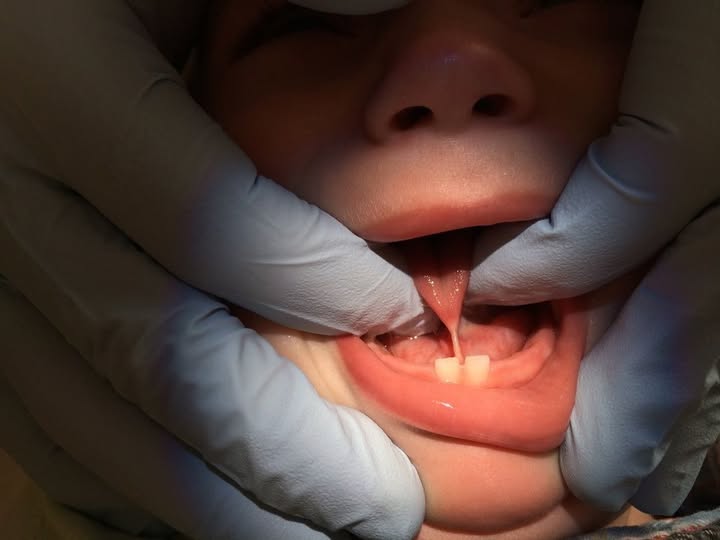Modern Dentistry, Timeless Smiles.
The Silent Struggle: A Manila Mother's Journey with Tongue-Tie
Language :

Topics:
Kamusta, mga Nanay at Tatay! Welcome back to Ngiting Pinoy, where we talk about dental health for every member of the family, from lolo to the newest bunso.
In the early morning haze of a Manila barangay, the familiar sound of a crying baby echoed from a small apartment. For Aling Susan, now a first-time grandmother, and her daughter, Maya, this sound was not the robust cry of a hungry baby but a frantic, frustrated wail. This is the story of baby Luna and the hidden condition that tested their first weeks together: tongue-tie, or pagkakatali ng dila.
The Frustrating First Weeks
Maya was determined to breastfeed. She had read all the books, attended the seminars. But from the start, something was wrong. Baby Luna would latch and unlatch constantly, clicking sounds accompanying her futile attempts. Feeding sessions stretched for over an hour, leaving both mother and baby exhausted and in tears. Luna was always hungry, yet wasn't gaining weight properly. Maya’s frustration grew, shadowed by a feeling of failure. "Bakit hindi ko kayang pakainin ang sarili kong anak?" she would whisper to her mother.
Aling Susan, with her traditional wisdom, noticed things others didn’t. "Parang hindi siya makasipsip ng maayos, ‘nak. Kitang-kita ko, ‘yung dila niya, parang nakakulong." She observed that Luna couldn't stick her tongue out past her gums. Her cry, instead of having a wide, open mouth, seemed constricted.
They visited their pedia in a nearby clinic in Mandaluyong. After a quick check, the doctor confirmed what Aling Susan had sensed. "Your daughter has a short lingual frenulum," the pediatrician explained. "It's what we call tongue-tie. The tissue under her tongue is too tight, restricting its movement. That's why she can't latch properly to create a good seal for breastfeeding."
The Turning Point: A Simple Procedure, A Life-Changing Result
The pediatrician referred them to a pediatric dentist in Ortigas. The dentist, Dra. Reyes, was gentle and reassuring. She confirmed the diagnosis—a Class III tongue-tie—and explained the solution: a frenotomy.
"Huwag kayong mangamba," Dra. Reyes said. "It's a quick and safe procedure. We'll simply snip the tight tissue to release the tongue. It’s over in seconds, and for a baby this young, there are very few nerve endings. She’ll be able to feed comfortably right after."
The procedure was as simple as promised. In a sterilized room, Dra. Reyes used a sterile scissors to make a precise snip. Luna let out a brief cry, but was soothed immediately in Maya’s arms. The moment she was offered the breast, the difference was miraculous. The frantic clicking was gone, replaced by a deep, rhythmic suckling. For the first time, feeding was peaceful.
Analysis: Why Early Diagnosis of Tongue-Tie is Crucial
Luna’s story is common, yet often missed. The implications of an undiagnosed tongue-tie go far beyond breastfeeding difficulties.
-
The Breastfeeding Dilemma: A baby needs to extend their tongue over the lower gum to form a seal and express milk. A tied tongue cannot do this, leading to poor milk transfer, nipple pain for the mother, and inadequate nutrition for the baby. This often leads to an early, undesired shift to formula feeding.
-
The Ripple Effect on Development:
-
Speech: As a child grows, the tongue needs to touch the roof of the mouth to form sounds like "t," "d," "l," and "r." A restricted tongue can lead to a lisp or unclear speech.
-
Oral Health: A mobile tongue is essential for sweeping food debris from the teeth. Restricted mobility can contribute to a higher risk of cavities.
-
Digestion: Proper chewing and swallowing, which starts with good tongue movement, is the first step of digestion.
-
Facial Growth: Normal tongue posture at the roof of the mouth encourages proper widening of the dental arch and facial development.
-
Innovate & Advise: Empowering Filipino Parents
How can you ensure your child isn't silently struggling?
-
Look for the Signs: Beyond breastfeeding trouble, look for a heart-shaped tip of the tongue when the baby cries, or an inability to lift the tongue to the roof of the mouth.
-
Seek the Right Specialist: Don’t hesitate to ask your pediatrician for a specific check. A pediatric dentist or an ENT (Ear, Nose, and Throat) specialist has the specific training to diagnose and treat tongue-ties.
-
Demand a Functional Assessment: It’s not just about how it looks, but how it functions. A qualified specialist will assess the tongue's range of motion and its impact on feeding.
-
Know the Solution is Simple: The fear of a procedure on a newborn is natural. But understanding that a frenotomy is a low-risk, high-reward intervention can provide immense relief. The benefits for feeding, bonding, and long-term development are profound.
For Maya and Luna, that simple snip was more than a medical procedure; it was the key that unlocked a world of comfortable feeding, peaceful bonding, and a healthy start. If you suspect your baby is struggling, trust your instinct as a parent. Your vigilance is the first step toward giving your child the freedom to eat, speak, and smile without restriction.




